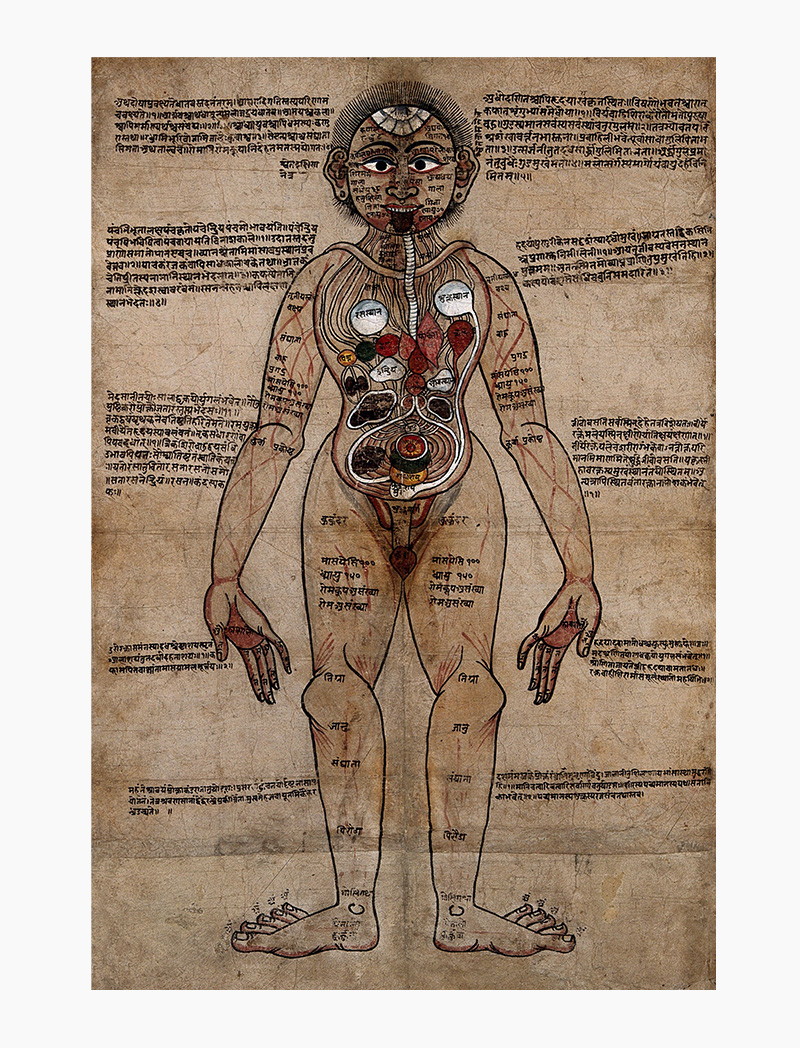PERSPECTIVES
Painting or a Diagram?: Looking at the Ayurvedic Man
The painting of Ayurvedic Man is a rare, yet unmatched, record of Ayurvedic practices in early India. It is a painting, dating to ca. 1800 CE, which portrays a human body in the manner of an anatomical drawing. Much like the cross-sectional anatomical charts that are a staple of elementary biology lessons, this painting reveals organs inside the human torso. Arranged in the form of rounded shapes and fluid channels, the organs are labelled appropriately in Sanskrit following Ayurvedic conventions. Significantly longer series of text are placed adjacent to the drawing – these are extracts from a sixteenth-century Ayurvedic compendium named Bhavaprakasha, authored by Bhava Mishra.
The remarkably exceptional quality of the painting lies in its composition. While it was standard practice for visual representations in painted manuscripts to derive their basis from oral and textual traditions — anything from myths and legends to political treatises and manuals — this painting is a feat that brings together image and text. This graphic language makes it easier for us to read the painting which serves not only as a visual representation of Ayurveda but also as a guided lesson in the medical tradition. The textual core of Ayurvedic tradition is usually invoked to indicate its long history and to draw legitimacy from it. In the case of this painting, the text serves as a point of reference for the reader, to help them understand what they are looking at.
However, reading the image through mere text offers us only a partial history of Ayurveda that this painting captures. The painting’s formal composition, in the style and rendition of hands and feet, their outward rotation, knee and elbow joints and overall posture reveal a direct influence of Tibetan medical painting, especially those illustrating bloodletting and acupuncture points. Even as a diagram, the painting incorporates the starkly open “living eyes” — traditionally used for depictions of gods, investing them with life and a divine presence. The depiction thus emerges out of an interaction of complex forms of image-making, combining sacred with medicinal, and illustrative with prescriptive.
The excerpts contain descriptions of physiology and anatomy, but function as both direct labels as well as deliberations on anatomical issues. The text on the face, for instance, labels different parts: eyelash, temple, cheek, gums, cheek, sinews, jaw. The organs in the torso are labelled — in keeping with the phlegmatic understanding of the body — as bile, wind, phlegm and places of semen, chyle and energy. While the organ for bile is yellow, as stated in the text, the one for phlegm is red, in contradiction to its stated colour, white. This inconsistent colour coding is curious, for it often deviated from textual recommendations, suggesting stylistic liberties taken by the artist.
It is considered highly likely that this painting was produced through a collaboration between an Ayurvedic physician, Tibetan artists and an uncredited calligrapher. Currently housed in the Wellcome Library in London, it entered their collection in 1986 as a flat painting, bearing no signs of being rolled up. The lasting freshness of its colours reveals that the painting had little outside exposure, and was likely displayed in a royal examination room, possibly used for teaching. Rich, unique and rare, this painting of the Ayurvedic Man offers a glimpse into the history of the Ayurvedic tradition that, despite its wealth of literature, has remained largely unillustrated.





